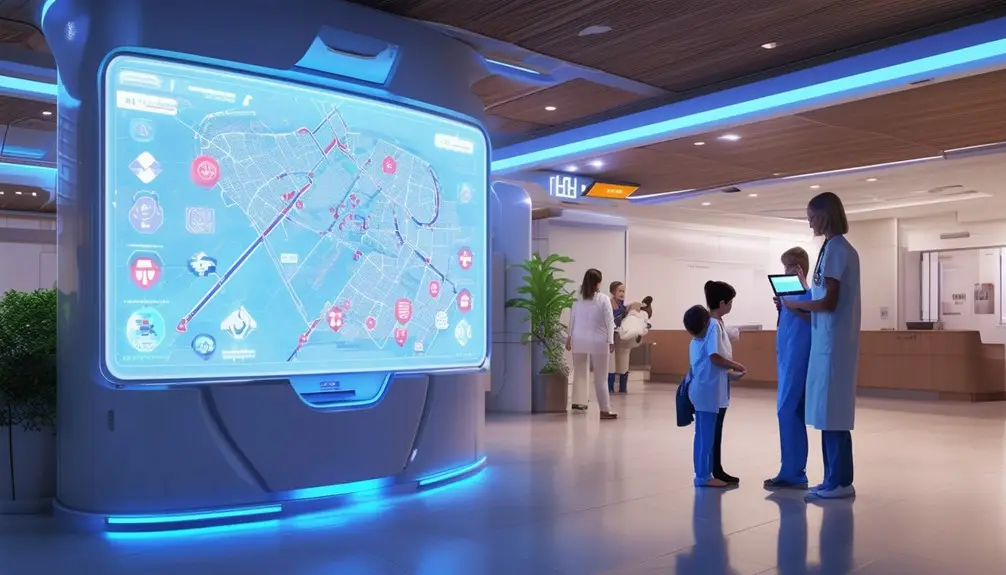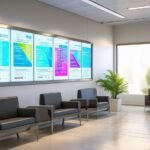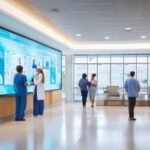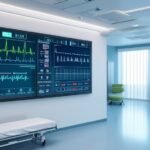You’re enhancing the healthcare experience with digital wayfinding technology, which originated at Brigham and Women’s Hospital. Leveraging mobile navigation apps, Bluetooth, and GPS, this technology offers real-time updates and improves operational efficiency. It’s designed to minimize patient anxiety and reduce missed appointments. Inclusive features like multi-lingual support, audio instructions, and high-contrast visuals guarantee accessibility for everyone. Implementations at places like Mercy Health and Boston Children’s Hospital highlight its effectiveness. Future innovations include 3D maps, AI-enhanced AR, and predictive algorithms. Discover how these advancements are set to transform modern healthcare facilities.
Key Takeaways
- Digital wayfinding reduces patient anxiety and missed appointments through easy navigation.
- Integration of mobile apps with Bluetooth and GPS provides real-time navigation updates.
- Enhanced accessibility features include multi-lingual support, tactile feedback, and high-contrast visuals.
- Real-time updates offer immediate information on appointment schedules and facility changes.
- Future innovations include 3D maps, AR smart glasses, and AI algorithms for optimized navigation.
History of Digital Wayfinding
Digital navigation technology, initially adopted to improve patient experiences at Brigham and Women’s Hospital, has evolved greatly over the years. The journey began with basic digital solutions aimed at simplifying navigation within intricate healthcare facilities. As you explore the history, you’ll see that these early implementations focused on reducing patient anxiety and minimizing missed appointments, thereby enhancing overall patient experience.
Over time, the integration of navigation apps expanded to other notable health systems like Mercy Health and Boston Children’s Hospital. These institutions recognized the potential benefits of digital navigation, such as streamlining the patient journey and making it easier for patients to locate various departments, clinics, and services within large hospital campuses.
The evolution of digital navigation technology didn’t stop there. With Dr. Mark Zhang leading Brigham’s Digital Innovation Hub, these solutions have grown more sophisticated. They’ve integrated with other digital tools to offer a seamless, all-encompassing approach to patient care. Today, digital navigation is a crucial component in the landscape of modern healthcare facilities, reflecting a significant shift from traditional, often confusing, navigational methods. This historical progression underscores the importance of continually advancing technology to effectively meet patient needs.
Key Technologies in Use
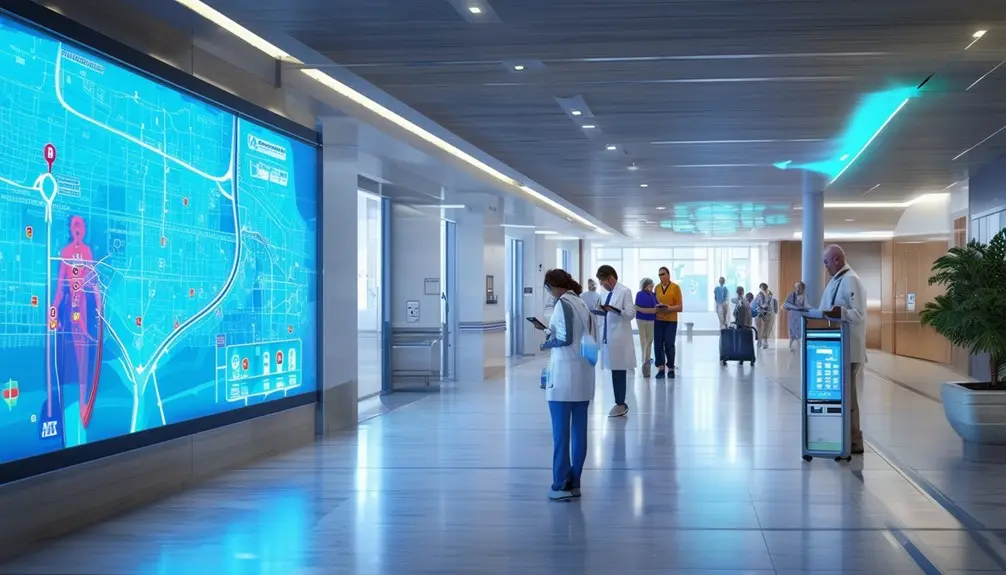
You can improve patient navigation with mobile apps that integrate Bluetooth and GPS for accurate, real-time updates. These technologies guarantee seamless wayfinding, reducing stress and enhancing overall patient satisfaction. By leveraging existing infrastructure, you also benefit from cost-effective solutions without the need for expensive hardware installations.
Mobile Navigation Apps
Mobile direction apps, such as those implemented by Mercy Health in Cincinnati and Boston Children’s Hospital, leverage radio transmitters and Bluetooth signals to provide precise indoor direction, greatly enhancing the patient experience. These mobile apps display detailed indoor maps and offer real-time information, making them a patient-centric solution for finding their way in complex healthcare environments.
For instance, patients using these apps can easily locate their way without the need for traditional wayfinding signage, which can often be perplexing. Additionally, these apps integrate appointment reminders and location services to guarantee patients arrive at their destinations on time, reducing the likelihood of missed or late appointments. This functionality is particularly vital in large medical facilities where finding the correct department or office can be challenging.
Bluetooth and GPS Integration
Building on the convenience of mobile navigation apps, Bluetooth Low Energy (BLE) and GPS technologies play a pivotal role in providing real-time, precise location tracking and seamless indoor-outdoor navigation within healthcare facilities. These technologies are essential to digital wayfinding systems, ensuring that patients and visitors can easily find their way.
BLE beacons and GPS technology work harmoniously to offer a complete navigation experience. Wayfinding apps leverage GPS for outdoor navigation and BLE for accurate indoor tracking. This integration allows you to shift smoothly from outdoor areas into the intricate indoor layouts of healthcare facilities without missing a beat.
Key benefits of Bluetooth and GPS integration include:
- Step-by-step directions: Receive detailed guidance through the facility.
- Floor-level perspectives: Access detailed maps of multi-floor buildings.
- Parking spot information: Easily locate and return to your parked vehicle.
Real-Time Updates
Real-time updates in digital wayfinding leverage GPS, BLE, and Wi-Fi to provide precise indoor navigation, guaranteeing seamless integration with mobile apps, browsers, and interactive kiosks for a superior user experience. By combining these technologies, you’re able to navigate complex healthcare facilities efficiently, decreasing anxiety and improving overall patient satisfaction.
Digital wayfinding technology’s real-time updates offer a dynamic solution that maximizes ROI by eliminating the need for costly RTLS hardware installations. Instead, BLE beacons and Wi-Fi signals work in tandem to deliver accurate location data directly to your smartphone. You can use mobile apps to receive turn-by-turn directions, while browsers and kiosks provide interactive maps and updates.
QR code signage strategically placed throughout healthcare facilities allows for quick access to real-time updates and directions. Simply scan a QR code with your mobile device to receive the latest information, making it easier to find your destination without hassle. This integration of GPS, BLE, and QR codes ensures that you have all the tools needed for seamless indoor navigation, ultimately enhancing your healthcare experience.
Incorporating these technologies into digital wayfinding not only streamlines navigation but also notably reduces operational costs, making it a practical and efficient solution for modern healthcare environments.
Benefits for Healthcare Facilities
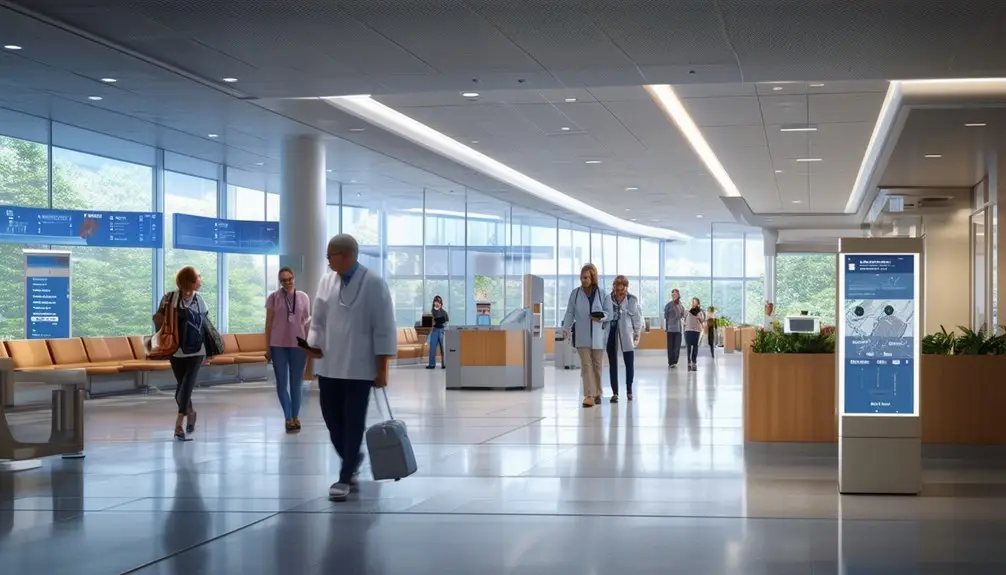
By implementing digital wayfinding technology, you can enhance operational efficiency through precise indoor navigation and location tracking. Real-time information updates improve accessibility for all patients, including those with disabilities. Additionally, these solutions streamline communication during emergencies, ensuring a safer environment for everyone.
Enhanced Operational Efficiency
Digital wayfinding technology optimizes healthcare facility operations by improving staff workflows and enhancing patient flow. A robust digital wayfinding solution enables staff to navigate complex healthcare facilities more efficiently, providing real-time information on room availability and patient locations. This, in turn, helps improve patient care by minimizing delays and reducing wait times.
By integrating digital wayfinding technology, healthcare facilities can boost operational efficiency in several ways:
- Enhanced Communication: Real-time information allows staff to respond quicker to patient needs and emergencies.
- Reduced Operational Costs: Less time is spent directing patients and visitors, freeing up staff for more critical tasks.
- Improved Patient Satisfaction: Efficient navigation and reduced wait times contribute to a better overall patient experience.
With enhanced communication channels, staff can locate patients and available rooms swiftly, ensuring that care is administered promptly and effectively. This immediate access to real-time information notably enhances operational efficiency, allowing healthcare facilities to focus more on delivering high-quality patient care. Additionally, the reduction in time spent on non-essential tasks translates to lower operational costs, making the facility more cost-effective. By streamlining these processes, digital wayfinding technology not only enhances the patient experience but also optimizes the overall functionality of healthcare facilities.
Improved Accessibility Features
Incorporating advanced accessibility features into wayfinding technology guarantees that healthcare facilities are not only inclusive but also comply with regulatory standards, thereby enhancing the overall patient experience. For patients and visitors, digital tools like audio instructions and closed captioning make finding a path in a hospital much easier, regardless of visual or hearing impairments. These accessibility features ensure that everyone can locate their way with minimal stress, supporting an inclusive environment.
Wayfinding systems that include multi-lingual support cater to diverse populations, making sure that language barriers don’t hinder effective direction. This is particularly critical in healthcare settings where clear communication can greatly impact patient outcomes. By offering directions and emergency messaging in multiple languages, hospitals improve both accessibility and safety for all users.
Additionally, these digital tools provide best-in-class directional guidance, greatly aiding individuals with disabilities. For instance, incorporating features such as tactile feedback and high-contrast visuals ensures that the wayfinding systems are usable by everyone. This commitment to accessibility not only meets regulatory requirements but also fosters a more welcoming and supportive healthcare environment. Ultimately, these advanced accessibility features make the hospital experience smoother and more efficient for patients and visitors alike.
Real-Time Information Updates
Healthcare facilities reap noteworthy benefits from real-time information updates through digital wayfinding technology, guaranteeing precise navigation and enhancing operational efficiency. When you leverage these systems, your facility can provide immediate updates on appointment schedules, facility layouts, and directional changes. This dynamic information dissemination minimizes confusion and notably improves the patient experience.
Using real-time information updates in your healthcare facility guarantees:
- Accurate navigation: Patients and visitors receive the most current directions, reducing the risk of getting lost.
- Operational efficiency: Timely updates on facility changes, such as room reassignments or service modifications, streamline internal processes.
- Enhanced patient experience: Regular updates on parking availability, facility closures, and new services make visits smoother and less stressful.
Real-time updates also allow your facility to quickly adjust routes and points of interest, accommodating new guidelines or emergencies like COVID-19. By keeping everyone informed, you reduce delays and enhance overall satisfaction. Incorporating digital wayfinding technology in your healthcare setting not only optimizes operational workflow but also guarantees that patients navigate the facility with confidence, reflecting positively on your institution’s reputation.
Enhanced Accessibility Features
Modern wayfinding technology ensures that individuals with disabilities can easily navigate healthcare facilities through advanced accessibility features like audio instructions and closed captioning. These features are essential for visually impaired individuals, enabling them to receive spoken directions that guide them seamlessly through complex environments. Digital wayfinding technology prioritizes accessibility, guaranteeing that everyone, regardless of their abilities, can achieve easy navigation.
In healthcare facilities, the integration of closed captioning allows individuals with hearing impairments to comprehend written instructions clearly, enhancing their overall experience. This technology’s data-driven approach ensures that spoken directions and closed captioning are consistently accurate and reliable, fostering an inclusive environment. The fusion of these accessibility features within digital wayfinding systems not only aids in navigation but also elevates patient confidence and independence.
Implementing such detailed and user-centric solutions underscores the healthcare industry’s dedication to inclusivity. By leveraging digital wayfinding technology equipped with spoken directions and closed captioning, healthcare facilities can provide superior guidance tailored to the needs of individuals with disabilities. This patient-focused approach not only improves accessibility but also guarantees that all patients and visitors can navigate healthcare environments with ease and confidence.
Case Studies of Implementation
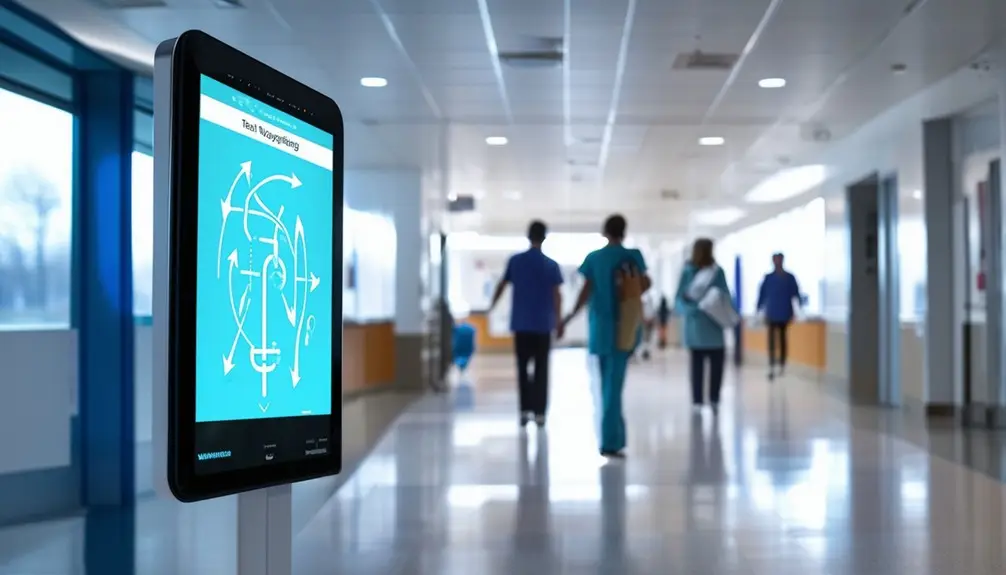
Frequently, real-world examples highlight the transformative impact of digital wayfinding technology in healthcare settings. Brigham and Women’s Hospital successfully implemented a digital wayfinding solution, greatly enhancing patient convenience. By utilizing real-time location data, patients and visitors can navigate the hospital more efficiently. This health system’s approach also includes interactive kiosks that further streamline the navigation process.
Mercy Health in Cincinnati took a similar route by introducing an in-hospital wayfinding app compatible with both Apple and Android devices. This innovation has not only improved navigation for patients and visitors but also reduced missed or late appointments. Appointment reminders integrated within the app ensure patients are punctual and well-informed about their healthcare engagements.
Boston Children’s Hospital offers another compelling case study with their MyWay app. This app simplifies navigation across their expansive healthcare campus, leveraging Bluetooth signals and radio transmitters for precise directions. The result is a more seamless experience for both patients and hospital employees.
Key benefits of these implementations include:
- Enhanced patient satisfaction and reduced stress
- Improved operational efficiency within health systems
- Lowered instances of missed or late appointments
These examples underscore how digital health advancements in wayfinding solutions can revolutionize patient experience and operational efficiency in healthcare environments.
Future Trends and Innovations
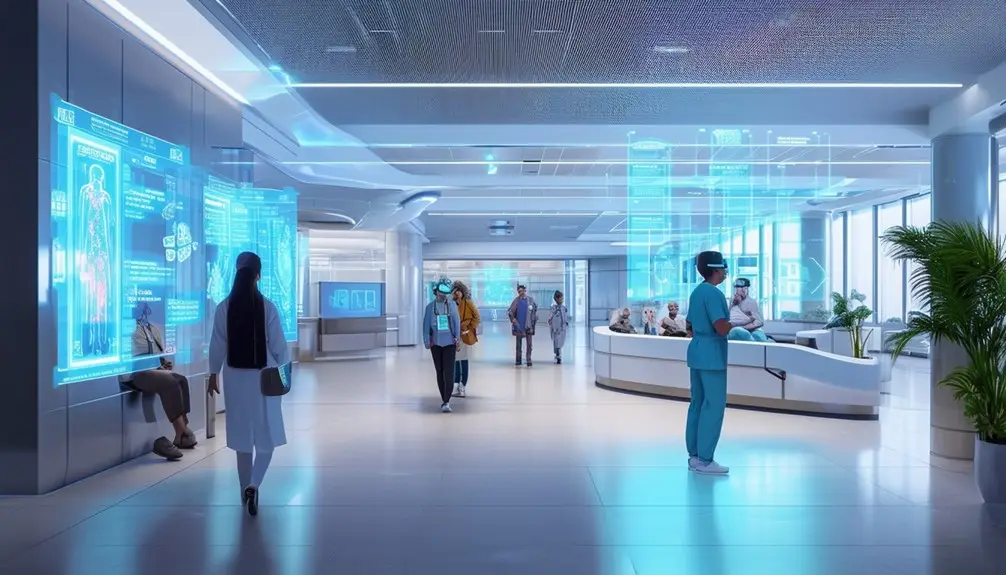
Building on these successful implementations, the next wave of digital wayfinding technologies in healthcare promises to harness 3D maps, AI-enhanced augmented reality (AR), and AR smart glasses to further enhance patient navigation and operational efficiency. Imagine walking into a hospital and instantly being guided by AR smart glasses that overlay 3D maps onto your field of vision. This technology can direct you to the nearest available parking spot, the correct department, and even the specific room you’re seeking.
AI-enhanced AR will greatly improve patient care by providing real-time, context-aware navigation. These systems can notify healthcare centers of your arrival, streamlining check-in procedures and reducing wait times. The integration of these advanced technologies will create a seamless experience, improving both patient satisfaction and operational efficiency.
Innovations in these areas are data-driven, focusing on enhancing every step of the patient journey. For instance, AI algorithms can predict peak times and suggest the best routes to avoid congestion. The use of 3D maps and AI-enhanced AR in healthcare not only modernizes patient navigation but also enhances the overall quality of care, making healthcare facilities more efficient and patient-centric.
Conclusion
To sum up, implementing digital wayfinding technology in healthcare transforms patient experiences and operational efficiency. Remember, ‘a stitch in time saves nine.’ These systems streamline navigation, reducing stress and delays while enhancing accessibility for all patients. Hospitals benefit from improved workflow and resource allocation. As technology advances expect even smarter, more intuitive solutions that continually improve patient satisfaction and facility performance. Embrace these innovations to stay ahead and provide superior care in an increasingly digital world.
Frequently Asked Questions
What Is Wayfinding in Healthcare?
Wayfinding in healthcare uses digital tools like apps and kiosks to guide you through medical facilities. You’ll get real-time navigation, interactive maps, and points of interest, enhancing your overall experience and reducing missed appointments.
What Is Digital Wayfinding?
Digital wayfinding uses technology like kiosks, mobile apps, and Bluetooth signals to help you navigate complex environments. You’ll get real-time directions, appointment reminders, and facility info, ensuring a smoother, more efficient experience within large facilities.
What Is the New Technology for Wayfinding?
New wayfinding technology includes mobile apps, interactive kiosks, and digital signage with GPS and BLE beacons. These tools integrate with EMRs for real-time updates, offering precise indoor navigation and custom routes, enhancing your overall patient experience.

